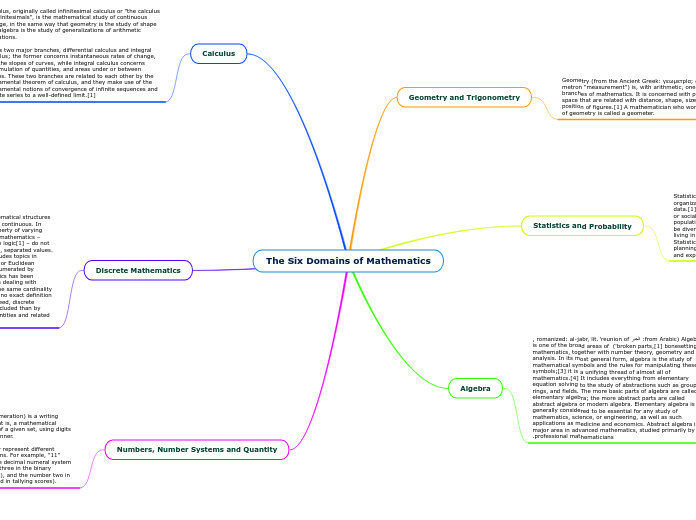The Six Domains of Mathematics
Geometry and Trigonometry
Geometry (from the Ancient Greek: γεωμετρία; geo- "earth", -metron "measurement") is, with arithmetic, one of the oldest branches of mathematics. It is concerned with properties of space that are related with distance, shape, size, and relative position of figures.[1] A mathematician who works in the field of geometry is called a geometer.
Statistics and Probability
Statistics is the discipline that concerns the collection, organization, analysis, interpretation, and presentation of data.[1][2][3] In applying statistics to a scientific, industrial, or social problem, it is conventional to begin with a statistical population or a statistical model to be studied. Populations can be diverse groups of people or objects such as "all people living in a country" or "every atom composing a crystal". Statistics deals with every aspect of data, including the planning of data collection in terms of the design of surveys and experiments.[4]
Algebra
Algebra (from Arabic: الجبر, romanized: al-jabr, lit. 'reunion of broken parts,[1] bonesetting[2]') is one of the broad areas of mathematics, together with number theory, geometry and analysis. In its most general form, algebra is the study of mathematical symbols and the rules for manipulating these symbols;[3] it is a unifying thread of almost all of mathematics.[4] It includes everything from elementary equation solving to the study of abstractions such as groups, rings, and fields. The more basic parts of algebra are called elementary algebra; the more abstract parts are called abstract algebra or modern algebra. Elementary algebra is generally considered to be essential for any study of mathematics, science, or engineering, as well as such applications as medicine and economics. Abstract algebra is a major area in advanced mathematics, studied primarily by professional mathematicians.
Calculus
Calculus, originally called infinitesimal calculus or "the calculus of infinitesimals", is the mathematical study of continuous change, in the same way that geometry is the study of shape and algebra is the study of generalizations of arithmetic operations.
It has two major branches, differential calculus and integral calculus; the former concerns instantaneous rates of change, and the slopes of curves, while integral calculus concerns accumulation of quantities, and areas under or between curves. These two branches are related to each other by the fundamental theorem of calculus, and they make use of the fundamental notions of convergence of infinite sequences and infinite series to a well-defined limit.[1]
Discrete Mathematics
Discrete mathematics is the study of mathematical structures that are fundamentally discrete rather than continuous. In contrast to real numbers that have the property of varying "smoothly", the objects studied in discrete mathematics – such as integers, graphs, and statements in logic[1] – do not vary smoothly in this way, but have distinct, separated values.[2][3] Discrete mathematics therefore excludes topics in "continuous mathematics" such as calculus or Euclidean geometry. Discrete objects can often be enumerated by integers. More formally, discrete mathematics has been characterized as the branch of mathematics dealing with countable sets[4] (finite sets or sets with the same cardinality as the natural numbers). However, there is no exact definition of the term "discrete mathematics."[5] Indeed, discrete mathematics is described less by what is included than by what is excluded: continuously varying quantities and related notions.
Numbers, Number Systems and Quantity
A numeral system (or system of numeration) is a writing system for expressing numbers; that is, a mathematical notation for representing numbers of a given set, using digits or other symbols in a consistent manner.
The same sequence of symbols may represent different numbers in different numeral systems. For example, "11" represents the number eleven in the decimal numeral system (used in common life), the number three in the binary numeral system (used in computers), and the number two in the unary numeral system (e.g. used in tallying scores).
